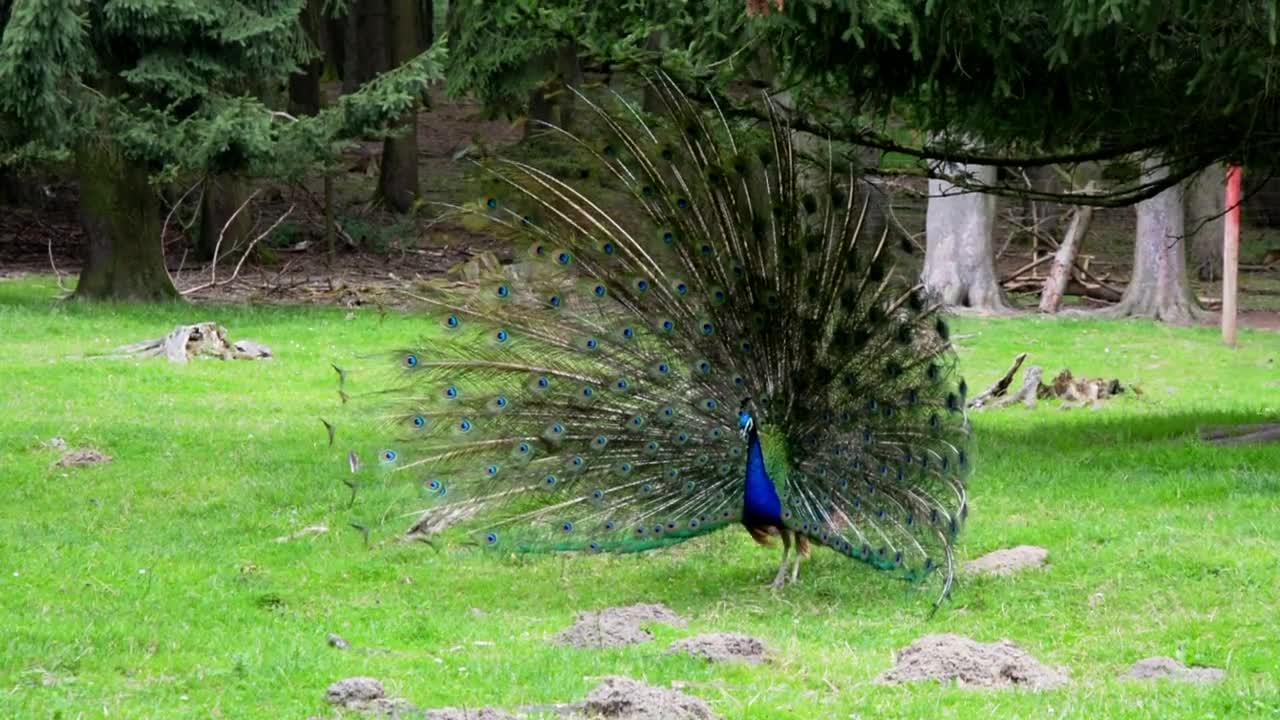Premium Only Content

A Male Peacock Showing Off His Eye-Spotted Tail
Either of three species of spectacular birds of the pheasant group, Phasianidae, known as peacocks or peafowls (order Galliformes). Both the male and female are peafowl, but the male is a peacock and the female is a peahen.The blue or Indian peacock (Pavo cristatus), found in India and Sri Lanka, and the green or Javanese peacock (Pavo muticus), found from Myanmar to Java, are the two most well-known peafowl species.
After a hunt that started in 1913 with the discovery of a single feather, the Congo peacock (Afropavo congensis) was found in 1936 in the forested interior of the Democratic Republic of the Congo.
The male of blue and green peacocks has a 90–130 cm (35–50 inch) body and a 150 cm (60 inch) train of dazzling metallic green tail feathers.The upper tail coverts of the pigeon, which are incredibly elongated, make up the bulk of this train.
Each feather has an iridescent eyespot surrounded by blue and bronze rings.
During courtship displays, the cock lifts his tail, which is under the train, lifting it and propelling it forward. The tail feathers are vibrated at the end of the show, giving the train's feathers a shimmering look and a rustling tone.
The body feathers of the blue peacock are mainly shiny blue-green. The green peacock has green and bronze body feathers and a train similar to the blue peacock. Both species' hens are green and brown in color and about as large as the males, but they lack the train and head decoration. Both species live in open lowland forests in the wild, flocking during the day and roosting high in trees at night. The male forms a harem of two to five hens during the breeding season, each of which lays four to eight whitish eggs in a depression in the ground.
The peahen incubates the eggs before they hatch, which takes about 28 days. When the chicks emerge from their nests, they have all of their feathers and are ready to fly over a week later. At three years of age, the majority of blue and green peafowl reach sexual maturity. Most blue peafowl males have been known to breed as early as two years old.
The peacock is a common ornamental bird in many zoos around the world, and it has a long history in the old World. Because of their violent nature, green peacocks in captivity must be kept apart from other fowl. Blue peacocks can survive northern winters despite being native to hot, humid climates. Green peacocks, on the other hand, are susceptible to cold.
The Congo peacock is Africa's only large phasianid. The cock has a short, rounded tail and is predominantly blue and green in colour. With a brown topknot, the hen is reddish and green. By adulthood, the population is smaller than others in the genus Pavo, rising to a length of 64 to 70 cm (25 to 28 inches).
The blue peafowl is classified as a species of least concern by the International Union for Conservation of Nature (IUCN). The IUCN, on the other hand, classified the green peacock to be an endangered species. Because of overhunting and the loss of vast areas of its natural habitat, the green peacock's population declined in the latter half of the twentieth century; the species is now estimated to number between 10,000 and 20,000 adults. The Congo peafowl is classified as an endangered species by the IUCN. Because of poaching and habitat destruction, its population has decreased to less than 10,000 adults.
-
 0:17
0:17
Wonbattle
4 years agoPeacock spread its tail
94 -
 2:53
2:53
VerumCrepitus
4 years ago $0.01 earnedF-22 Raptor Showing Off
102 -
 0:41
0:41
STLNutritionDoc
4 years agoKids showing off closet
28 -
 0:08
0:08
Fun at RejuveCat
4 years ago $0.04 earnedGin-Gin showing off his leaping skills
136 -
 0:23
0:23
STLNutritionDoc
4 years agoNoah showing his lego construction
41 -
 1:52:43
1:52:43
Dome After Dark
5 hours agoDome After Dark: Monday Night Hangout!
12.3K -
 LIVE
LIVE
RyuMuramasa✧
5 hours agoLimveld's Destiny | Elden Ring Nightreign | LIVE Full Walkthrough!
36 watching -
 1:52:45
1:52:45
Robert Gouveia
7 hours agoTrump at SUPREME COURT! Election Lawsuit ACCEPTED! Gun Rights IGNORED!
53.2K13 -
 12:34
12:34
From The Desk Of Anthony Pompliano
8 hours ago $6.86 earnedElon Musk & Marc Andreessen Agree: Robotics Will Eclipse EVERYTHING
53K5 -
 2:40:44
2:40:44
Fragniac
6 hours ago🔴THE FINAL STREAM ...💥 ─╦ ╤ (•_-) - CLIP EVERYTHING❗🎬📽 🎞
14.8K1